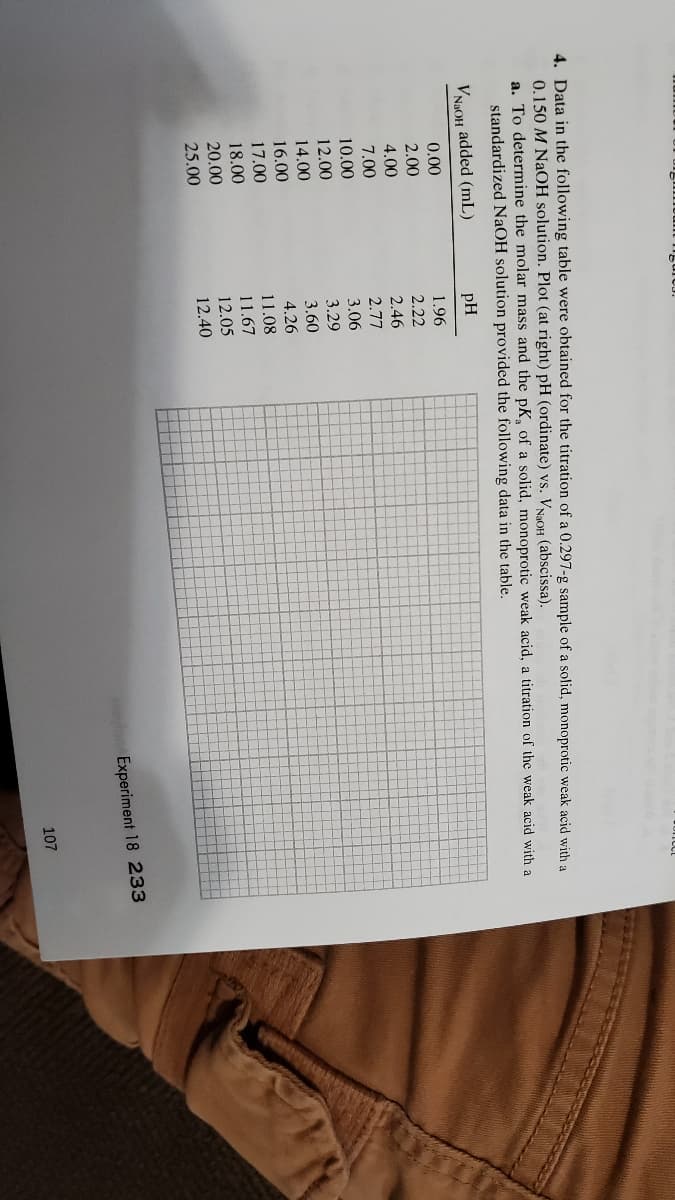4. Data in the following table were obtained for the titration of a 0.297-g sample of a solid, monoprotic weak acid with a 0.150 M NAOH solution. Plot (at right) pH (ordinate) vs. VNOH (abscissa). a. To determine the molar mass and the pK, of a solid, monoprotic weak acid, a titration of the weak acid with a standardized NaOH solution provided the following data in the table. VNaOH added (mL) pH 0.00 1.96 2.00 4.00 2.22 2.46 7.00 2.77 10.00 3.06 12.00 3.29 14.00 3.60 4.26 16.00 17.00 18.00 11.08 11.67 20.00 12.05 25.00 12.40 Experiment 18 233
4. Data in the following table were obtained for the titration of a 0.297-g sample of a solid, monoprotic weak acid with a 0.150 M NAOH solution. Plot (at right) pH (ordinate) vs. VNOH (abscissa). a. To determine the molar mass and the pK, of a solid, monoprotic weak acid, a titration of the weak acid with a standardized NaOH solution provided the following data in the table. VNaOH added (mL) pH 0.00 1.96 2.00 4.00 2.22 2.46 7.00 2.77 10.00 3.06 12.00 3.29 14.00 3.60 4.26 16.00 17.00 18.00 11.08 11.67 20.00 12.05 25.00 12.40 Experiment 18 233
Chemistry: The Molecular Science
5th Edition
ISBN:9781285199047
Author:John W. Moore, Conrad L. Stanitski
Publisher:John W. Moore, Conrad L. Stanitski
Chapter15: Additional Aqueous Equilibria
Section: Chapter Questions
Problem 93QRT: When 40.00 mL of a weak monoprotic acid solution is titrated with 0.100-M NaOH, the equivalence...
Related questions
Question
4. a) Data in the following table are obtained for the titration of 0.297g sample of a solid, monoprotic weak acid with a 0.150M NaOH solution. Plot PH vs. V.

Transcribed Image Text:4. Data in the following table were obtained for the titration of a 0.297-g sample of a solid, monoprotic weak acid with a
0.150 M NaOH solution. Plot (at right) pH (ordinate) vs. VNOH (abscissa).
a. To determine the molar mass and the pK, of a solid, monoprotic weak acid, a titration of the weak acid with a
standardized NaOH solution provided the following data in the table.
VNaOH added (mL)
pH
0.00
2.00
1.96
2.22
4.00
2.46
7.00
2.77
10.00
3.06
12.00
3.29
14.00
3.60
16.00
4.26
17.00
11.08
11.67
12.05
18.00
20.00
25.00
12.40
Experiment 18 233
107
Expert Solution
This question has been solved!
Explore an expertly crafted, step-by-step solution for a thorough understanding of key concepts.
This is a popular solution!
Trending now
This is a popular solution!
Step by step
Solved in 2 steps with 2 images

Knowledge Booster
Learn more about
Need a deep-dive on the concept behind this application? Look no further. Learn more about this topic, chemistry and related others by exploring similar questions and additional content below.Recommended textbooks for you

Chemistry: The Molecular Science
Chemistry
ISBN:
9781285199047
Author:
John W. Moore, Conrad L. Stanitski
Publisher:
Cengage Learning

Chemistry: Principles and Practice
Chemistry
ISBN:
9780534420123
Author:
Daniel L. Reger, Scott R. Goode, David W. Ball, Edward Mercer
Publisher:
Cengage Learning


Chemistry: The Molecular Science
Chemistry
ISBN:
9781285199047
Author:
John W. Moore, Conrad L. Stanitski
Publisher:
Cengage Learning

Chemistry: Principles and Practice
Chemistry
ISBN:
9780534420123
Author:
Daniel L. Reger, Scott R. Goode, David W. Ball, Edward Mercer
Publisher:
Cengage Learning


Principles of Modern Chemistry
Chemistry
ISBN:
9781305079113
Author:
David W. Oxtoby, H. Pat Gillis, Laurie J. Butler
Publisher:
Cengage Learning

Chemistry: An Atoms First Approach
Chemistry
ISBN:
9781305079243
Author:
Steven S. Zumdahl, Susan A. Zumdahl
Publisher:
Cengage Learning

Chemistry
Chemistry
ISBN:
9781305957404
Author:
Steven S. Zumdahl, Susan A. Zumdahl, Donald J. DeCoste
Publisher:
Cengage Learning